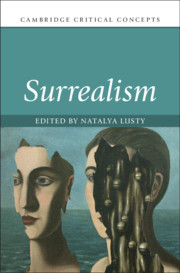Book contents
- Surrealism
- Cambridge Critical Concepts
- Surrealism
- Copyright page
- Contents
- Illustrations
- Notes on Contributors
- Acknowledgments
- Introduction: Surrealism’s Critical Legacy
- Part I Origins: Ideas/Concepts/Interventions
- Part II Developments: Practices/Cultures/Material Forms
- Part III Applications: Heterodoxies and New Worlds
- Chapter 14 Surrealism and Schizoanalysis
- Chapter 15 The Surrealist Bestiary and Animal Philosophy
- Chapter 16 Picasso’s Habits: André Breton on Art, Nature and Reflexivity
- Chapter 17 Surrealism and Mass-Observation
- Chapter 18 Pacific Surrealism
- Chapter 19 Decolonial Surrealism
- Chapter 20 Surrealism and écriture féminine
- Chapter 21 Subcultural Receptions of Surrealism in the 1960s International Underground Press
- Select Bibliography
- Index
Chapter 15 - The Surrealist Bestiary and Animal Philosophy
from Part III - Applications: Heterodoxies and New Worlds
Published online by Cambridge University Press: 23 July 2021
- Surrealism
- Cambridge Critical Concepts
- Surrealism
- Copyright page
- Contents
- Illustrations
- Notes on Contributors
- Acknowledgments
- Introduction: Surrealism’s Critical Legacy
- Part I Origins: Ideas/Concepts/Interventions
- Part II Developments: Practices/Cultures/Material Forms
- Part III Applications: Heterodoxies and New Worlds
- Chapter 14 Surrealism and Schizoanalysis
- Chapter 15 The Surrealist Bestiary and Animal Philosophy
- Chapter 16 Picasso’s Habits: André Breton on Art, Nature and Reflexivity
- Chapter 17 Surrealism and Mass-Observation
- Chapter 18 Pacific Surrealism
- Chapter 19 Decolonial Surrealism
- Chapter 20 Surrealism and écriture féminine
- Chapter 21 Subcultural Receptions of Surrealism in the 1960s International Underground Press
- Select Bibliography
- Index
Summary
Surrealist practice of the early twentieth century anticipates the biopolitics of contemporary animal philosophy. Modern surrealists welcomed Charles Darwin's paradigm shift, moving beyond any bright line that distinguished humans as a species from the rest of the animal kingdom. Surrealism's investment in evolutionary biology – promoted in journals such as Minotaure, Documents, and View – buttressed its political critique of humanist exceptionalism, sovereign individualism, and any ideal telos that defined the origins and destiny of humankind. Although surrealist animal representations frequently lapse into anthropocentric fantasy, surrealist manifestoes, art, poetry, fiction, and drama remain undeniably revolutionary in depicting human/animal hybridity and assailing the oppressive discursive linkages among classism, colonialism, and speciesism. In particular, the later careers of surrealists such as Leonora Carrington look ahead to recent ecofeminist and environmental debates concerning an “ethic of care,” defining kinship and companion networks in a decidedly posthuman community of human and nonhuman animals.
Keywords
- Type
- Chapter
- Information
- Surrealism , pp. 272 - 290Publisher: Cambridge University PressPrint publication year: 2021



